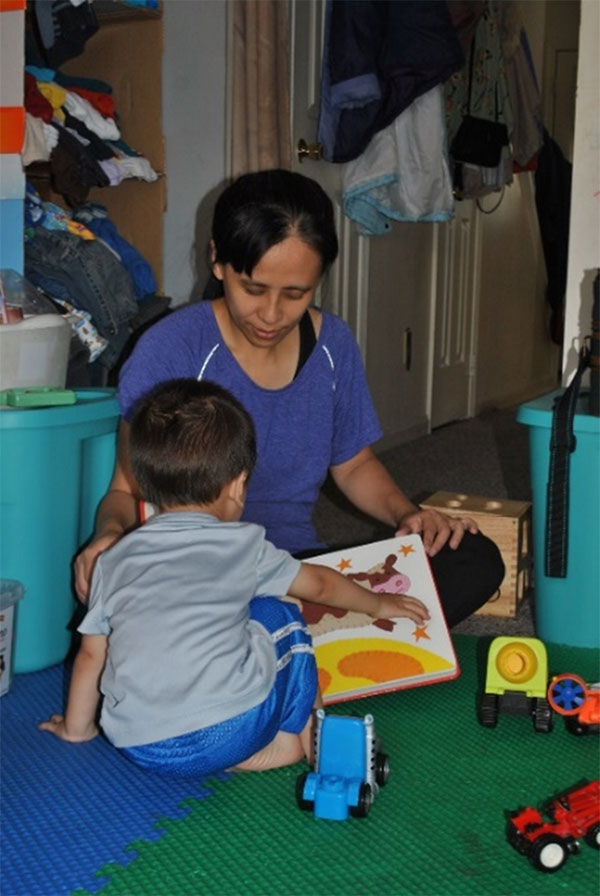Language and Literacy Video Clip
Open Doors
Chapter 10a: Language and Literacy Experience It
Mom: Hi. Can you smile? Can you smile? Yeah? Wow. Hi. Do you feel better now? Yeah? You do? Feel better? What? What?
[Baby cooing]
Mom: You want to see Buffy for a second? You want to see Buffy? Huh, you want to see Buffy? I can wash my hands. Yeah. Hi. What's that? Okay.
[Inaudible]
Dad: Okay.
Open Doors
Chapter 10a: Language and Literacy Experience It
Mom: Hi. Can you smile? Can you smile? Yeah? Wow. Hi. Do you feel better now? Yeah? You do? Feel better? What? What?
[Baby cooing]
Mom: You want to see Buffy for a second? You want to see Buffy? Huh, you want to see Buffy? I can wash my hands. Yeah. Hi. What's that? Okay.
[Inaudible]
Dad: Okay.
Reflections
What did you observe?
Answers may include:
- The mother is putting on the baby's clothes and talking to her the whole time
- The baby is focused on the mother's face throughout the dressing process, and the mother is focused on the baby's face when she is on camera, except when she needs to look at what she is doing
- Mother asks several questions, such as, "Can you give me a smile?" and repeats it while she is smiling
- Baby stays focused on her face and makes a noise. She asks, "Do you feel better now?"
- The baby grunts and mother imitates baby's noise
- The mother gently touches the baby's eye
- The mother asks, "Do you want to see Poppy?" then waits and looks at the baby as she zips up the suit
- Then the father comes and takes the baby
How does this interaction support language and literacy?
Answers may include:
- Mother talks to baby in a soft, friendly voice and smiles at baby frequently
- Mother asks questions and changes her tone from talking to questioning
- Mother imitates baby's sounds, which will reinforce the baby making more sounds in a back-and-forth "conversation"
- Baby stays focused on mother and shows enjoyment in listening to mother's voice, which reinforces mother talking to baby
- When mother asks questions, they are related to what she is doing so the baby will learn that language means something; for example:
- "Can you smile?" and she smiles
- "Do you want to go to Poppy?" and Poppy picks her up
What other domains supporting school readiness did you see?
Answers may include:
- Cognition
- Cause and Effect
- Mother asks a question or says something to baby and follows up with a related action
- "Can you give me a smile?" and smiles
- "Do you want to go to Poppy?" and Poppy picks her up
- Mother asks a question or says something to baby and follows up with a related action
- Cause and Effect
- Perceptual, Motor, and Physical Development
- Changing diaper
- Mother gently placing baby's arms and legs into clothing
- Safety:
- Having another adult pick the baby up while mother disposes of dirty diaper
- Baby kicking and moving her arms
- Social and Emotional Development
- Mother and baby engaging in face-to-face interaction
- Mother smiling at baby
- Baby making noises and mother responding
- Baby focused on mother's face as she talks
- Baby kicking and moving her arms in response to mother's talking to her
How could you encourage a parent to engage in this kind of interaction during diapering or changing?
Answers may include:
- Look for moments when the baby is looking at or paying attention to the parent and point them out
- "See how she looks at you when you talk while you're changing her diaper?"
- Talk for the baby
- "You want Mommy to look at you, don't you?"
- "I'm trying to say something to you, Daddy."
- "I like it when you talk to me when you change my diaper."
- Look for moments when the parent is talking or being responsive to the baby and comment on it
- "She really pays attention when you talk to her."
- "Look at her face when you smile; she just lights up."
- "She put her hand out to help when you told her you were going to put her sleeve on her. She really responded when you told her what you were going to do."
Reflect on moments in home visits when you can help support the parent in promoting the child's language and literacy.
Answers may include:
- Encourage the child to take books to the parent
- Get excited with the parent when the child uses new words
- Encourage the parent to look at or read books with the child; sit nearby to encourage and offer support
- "She really likes when you just let her chew on the book or turn the pages. Those are the first steps toward learning to read."


 Although language and literacy are two different skills, they are closely related. Language is the ability to both use and understand spoken words or signs. It is all about ideas passing from one person to another. Literacy is the ability to use and understand written words or other symbols in order to communicate. Language and literacy learning begins prenatally. The child learns the sounds and rhythms of his or her home language in the womb and can develop a love of reading by being read to as a newborn. The ELOF provides a detailed progression of the knowledge and skills a child achieves in these domains.
Although language and literacy are two different skills, they are closely related. Language is the ability to both use and understand spoken words or signs. It is all about ideas passing from one person to another. Literacy is the ability to use and understand written words or other symbols in order to communicate. Language and literacy learning begins prenatally. The child learns the sounds and rhythms of his or her home language in the womb and can develop a love of reading by being read to as a newborn. The ELOF provides a detailed progression of the knowledge and skills a child achieves in these domains.